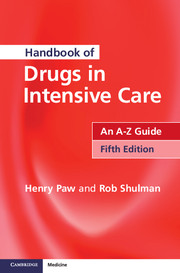Book contents
- Frontmatter
- Contents
- Introduction
- How to use this book
- Abbreviations
- Acknowledgements
- DRUGS: AN A–Z GUIDE
- SHORT NOTES
- Routes of administration
- Loading dose
- Drug metabolism
- Enzyme systems
- Drug excretion
- Drug tolerance
- Drug interactions
- Therapeutic drug monitoring
- Target range of concentration
- Pharmacology in the critically ill
- Cardiopulmonary resuscitation
- Drugs in advanced life support
- Management of acute major anaphylaxis
- Management of severe hyperkalaemia
- Management of malignant hyperthermia
- Sedation, analgesia and neuromuscular blockade
- A practical approach to sedation and analgesia
- Opioid Conversion table
- Management of status epilepticus
- Prevention of delirium tremens and alcohol withdrawal syndrome
- Prevention of Wernicke–Korsakoffsyndrome
- Anti-arrhythmic drugs
- Inotropes and vasopressors
- Bronchospasm
- Anti-ulcer drugs
- Immunonutrition in the ICU
- Corticosteroids
- Short synacthen test
- Bone marrow rescue following nitrous oxide
- Antioxidants
- Post-splenectomy prophylaxis
- Anti-microbial drugs
- Bacterial gram staining
- Antibiotics: sensitivities
- Renal replacement therapy
- Extracorporeal drug clearance: basic principles
- Drug doses in renal failure/renal replacement therapy
- Chemical pleurodesis of malignant pleural effusion
- APPENDICES
- DRUG INDEX
- IV COMPATIBILITY CHART
Management of status epilepticus
Published online by Cambridge University Press: 05 November 2014
- Frontmatter
- Contents
- Introduction
- How to use this book
- Abbreviations
- Acknowledgements
- DRUGS: AN A–Z GUIDE
- SHORT NOTES
- Routes of administration
- Loading dose
- Drug metabolism
- Enzyme systems
- Drug excretion
- Drug tolerance
- Drug interactions
- Therapeutic drug monitoring
- Target range of concentration
- Pharmacology in the critically ill
- Cardiopulmonary resuscitation
- Drugs in advanced life support
- Management of acute major anaphylaxis
- Management of severe hyperkalaemia
- Management of malignant hyperthermia
- Sedation, analgesia and neuromuscular blockade
- A practical approach to sedation and analgesia
- Opioid Conversion table
- Management of status epilepticus
- Prevention of delirium tremens and alcohol withdrawal syndrome
- Prevention of Wernicke–Korsakoffsyndrome
- Anti-arrhythmic drugs
- Inotropes and vasopressors
- Bronchospasm
- Anti-ulcer drugs
- Immunonutrition in the ICU
- Corticosteroids
- Short synacthen test
- Bone marrow rescue following nitrous oxide
- Antioxidants
- Post-splenectomy prophylaxis
- Anti-microbial drugs
- Bacterial gram staining
- Antibiotics: sensitivities
- Renal replacement therapy
- Extracorporeal drug clearance: basic principles
- Drug doses in renal failure/renal replacement therapy
- Chemical pleurodesis of malignant pleural effusion
- APPENDICES
- DRUG INDEX
- IV COMPATIBILITY CHART
Summary
Status epilepticus is defined as continuous seizure activity lasting >30 min or more than two discrete seizures, between which the patient does not recover consciousness. About 50% of patients have known epilepsy, and status may be secondary to poor drug compliance with anticonvulsant therapy, a change in anticonvulsant therapy or alcohol withdrawal. Other causes of status epilepticus are listed below.
History of epilepsy
• Poor compliance
• Recent change in medication
• Drug interactions
• Withdrawal of the effects of alcohol
• Pseudostatus
No history of epilepsy
• Intracranial tumour/abscess
• Intracranial haemorrhage
• Stroke
• Head injury or surgery
• Infection – meningitis, encephalitis
• Febrile convulsions in children
• Metabolic abnormalities – hypoglycaemia, hypocalcaemia, hyponatraemia, hypomagnesaemia, hypoxia
• Drug toxicity
• Drug or alcohol withdrawal
• Use of antagonists in mixed drug overdoses
Status epilepticus is divided into four stages. There is usually a preceding period of increasing seizures – the premonitory stage, which can be treated with a benzodiazepine such as clobazam 10 mg. Early treatment at this stage may prevent the development of the next stage. Early status epilepticus can usually be terminated by an IV bolus of lorazepam 4 mg, repeated after 10 min if no response. If there is no response to benzodiazepine therapy after 30 min, established status epilepticus has developed and either phenobarbital, phenytoin or fosphenytoin should be given.
- Type
- Chapter
- Information
- Handbook of Drugs in Intensive CareAn A-Z Guide, pp. 270 - 273Publisher: Cambridge University PressPrint publication year: 2014



